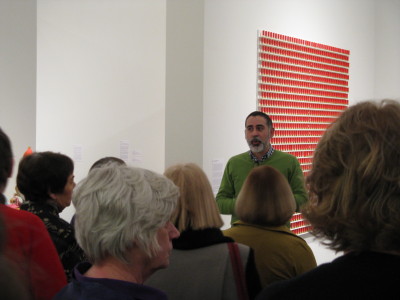CQA attends “High
Fiber Diet: BAM Biennial 2012”
Symposium, Saturday,
February 9, 2013
By Donna DeShazo
CQA members were front and center at the Bellevue (WA) Arts Museum
The symposium was themed to explore BAM’s current showing,
“High Fiber Diet,” an exhibit that brought together more than 40 contemporary
artists in shining a spotlight on fiber art created in the Northwest. Describing
the exhibit, BAM’s material says, “With its versatility and ready availability,
fiber has long had its firm place in the Do-It-Yourself movement, yet is often
underexposed in the traditional art world.”
More than 80 attendees joined BAM’s Director of Art, Craft
and Design, Stefano Catalani, curator of the fiber exhibit, as he kicked off
the day’s events with a quick highlights tour of the various elements in the
exhibit that range from cedar baskets in organic shapes, to a hand-knit shroud,
a “torso teapot,” and a colorful folded “blanket” made entirely of layers of
paint.
Opening the formal part of the symposium was a keynote
presentation on “The Long History Behind Contemporary Craft in Fiber” by Elissa
Auther, Associate Professor of Contemporary Art, University
of Colorado , and Adjunct Curator at
the Museum of Contemporary
Art , Denver .
She noted that some of the earlier (1960s) exhibits of fiber in traditional art
venues comprised sculptural works and were dismissed by critics as “decorative,”
or “gender-specific,” or “ethnographic,” and more representative of everyday
experiences than true “art.” It was the old question of art vs. craft, and
where fiber work fell in the hierarchy of arts and crafts. She noted that the
craft of fiber was taken over by the counterculture in the ‘70s, when it was
deemed handmade and authentic, and that the same movement is occurring again as
DIY and young activists now lend it the aura of sustainability.
Rounding out the morning session was a panel moderated by Barbara
Lee Smith, an artist currently working in Gig
Harbor , WA
Marci Rae McDade, editor of Surface Design Journal, moderated the afternoon discussion titled
“Time of Arrival, Point of Departure,” with panelists Vanessa Calvert, Scott
Fife, Margie Livingston and Michael Cepress. Both the panelists and the
audience were intrigued by the introduction and use of the term
“dishabituation,”meaning the surprise from something not being what it looks
like, e.g. Livingston’s painted “blankets” that look to be piles of folded, soft
fabrics but that are actually relatively hard layers upon layers of paint. A
great quote from this session: In response to viewers wondering if an art piece
out of paint (or fiber) is truly art, “It’s your preconceived notion about
(paint) (fiber) that’s holding (paint) (fiber) back.” Another: “Wearable art is
now sculpture on the body…fashion hasn’t had a place in the fiber arts world
until just recently.” And yet another: “The artist’s job is to show people what
they don’t know they need to see.”
Rounding out the day was a presentation titled “Then and
Now” by Lia Cook, Professor of Textiles and Fine Arts at California College of
the Arts, Oakland CA, whose work is in permanent collections of major
international museums. She noted that the concepts of collaboration and sharing
are strong these days, unlike the ‘90s when work was more individual, and that “nature,
natural and local” are highly desirable. There’s more concern over toxicity,
promoting a return to natural dyes. She also pointed out changes in social
practices, an example being engaging people in the process by bringing looms
and weavers into public spaces. She showed illustrations of brain-wave imagery
via MRIs that’s providing a springboard for some of her own newer works in
moving from weaving techniques into video imagery. Part of her video
presentation—a work by another weaver--had the audience spellbound even as we
were not sure just what we were seeing, let alone how to describe it. Best that
can be said is that it was a constantly forming and reforming black-and-white
visual of a marching band, complete with both music and loom sounds, being
produced by the stitches of a jacquard loom in full motion. Stunning!





No comments:
Post a Comment